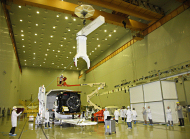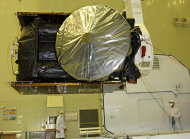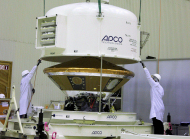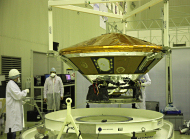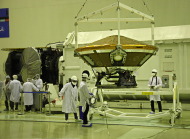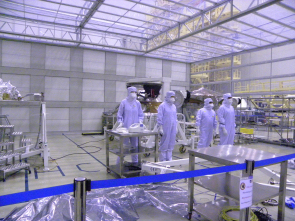Busy in Baikonur: a look back at the first few weeks for ExoMars 2016 at the cosmodrome
22 January 2016
One month ago, the ExoMars 2016 Trace Gas Orbiter and Schiaparelli (the entry, descent and landing demonstrator module) travelled aboard two Antonov 124 cargo jets from Turin, Italy, to the Baikonur Cosmodrome in Kazakhstan to be readied for launch in March.Since then, engineering teams, totaling about 65 people, from Thales Alenia Space (Italy and France), the ExoMars project team, instrument teams, and specialists from the Baikonur cosmodrome have been steadily working through an intensive and painstaking programme of final testing and preparation of the two spacecraft, which at 4.3 metric tonnes will be the heaviest spacecraft composite ever to be sent to Mars.
All this has to be completed in time for a launch scheduled for 14 March at the beginning of the 12-day launch window for this mission.
Focussed on the task at hand
The teams at Baikonur spend most of their time on-site at the cosmodrome. They live in two hotels situated about 3 km from the spacecraft integration and office area, and 6 km from the launch pad. The relative proximity to the launch pad means that during night launches the hotel is evacuated for safety reasons – this was the case for a launch in December shortly after some of the ExoMars team had arrived, and will happen for the launch of a Eutelsat at the end of this month. Every Monday to Saturday a bus picks the teams up at 08:00 and brings them back to the hotel between 18:30 to 20:30. Some team members occasionally work double shifts, from 06:30 to 22:00, or even night shifts, which are typically reserved for hazardous operations, such as work on pyros (explosive bolts), and fuelling.
There is, however, some respite from this busy schedule: late on Saturday afternoons there is a bus into Baikonur city, which is 70 km away, where the teams can spend the weekend until Sunday evening.
The typical working day starts with a short meeting for the ESA and Thales Alenia Space experts at 08:30 and then a meeting with their Russian counterparts (from Roscosmos, Krunichev, and TsENKI) at 09:30, to discuss daily planning and logistics. And then, it is all hands on deck.
The centre of the action
Central to the launch campaign activities is the cleanroom. Almost everything in the cleanroom has been transported from Europe for this launch campaign – hence the need for a third Antonov flight. In addition to the specialist lifting equipment and the ground support trolleys needed to move the two spacecraft, the teams have also had to prepare a dedicated ISO 7 environment cleanroom tent, within the "normal" ISO 8 cleanroom environment, for handling Schiaparelli which, being a Mars lander, must be regularly sampled to check that it satisfies the planetary protection regulations. For analysis of these samples a dedicated microbiological laboratory was brought from Turin and installed close to the cleanroom area.
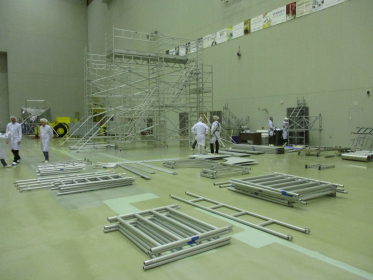 |
 |
| Building the basics. Credit: ESA - A. Haldemann | |
 |
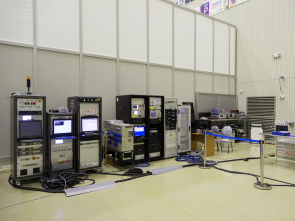 |
| Preparing the clean tent for Schiaparelli. Credit: ESA - A. Haldemann |
Ground support equipment. Credit: ESA - B. Bethge |
The readying of the Trace Gas Orbiter has included a series of system health checks, such as checking that signals could be sent to all spacecraft units and that they responded. The health of the payload – the four science instruments, ACS, CaSSIS, FREND and NOMAD – was checked in a similar manner by verifying that commands could be sent to them and that these commands were carried out. The flight model of FREND was swapped for the flight spare model – see the article about TGO's best FREND.
 |
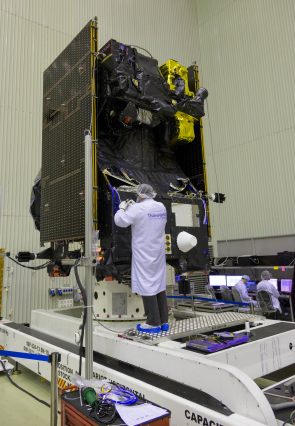 |
 |
|
|
Two views of the Trace Gas Orbiter. Credit: ESA - A. Haldemann |
Preparing the Trace Gas Orbiter for testing. Credit: ESA - B. Bethge |
Another important test that has been completed was with the Trace Gas Orbiter and the launch vehicle adapter. Mechanical fit checks and separation tests had already been done in Cannes last year. Here in Baikonur, the team checked the mechanical connections, and also verified that all electrical circuits were completed.
 |
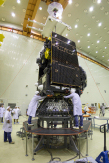 |
 |
|
The Trace Gas Orbiter and launch vehicle adapter. Credit: ESA - B. Bethge |
The Launch vehicle adapter. Credit: ESA - A. Haldemann |
|
Safety first and attention to detail
The propellants used for ExoMars's propulsion systems are highly toxic and corrosive, so it is important both for the correct operation of the mission and for the safety of the ground processing personnel during fuelling and subsequent ground operations that there are no leaks in the systems.
TGO full leak tests had already been performed before shipment in its transport container - this was the last activity before TGO left the Thales Alenia Space facility in Cannes. In Baikonur, the tests were restricted to checking the fill and drain valves and the thruster valves. These tests were carried out by pressurising the propulsion systems with helium and searching for leaks with a mass spectrometer connected to a sniffer probe. Any rise above the baseline level of helium present in the atmosphere would have indicated a leak. Fortunately, no leaks were detected.
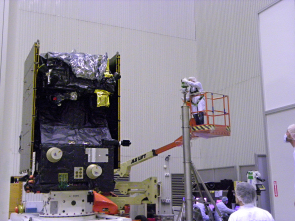 |
|
Alignment tests on the Trace Gas Orbiter. Credit: Thales Alenia Space |
Of course, when handling the spacecraft great care is taken, but it is still possible that minute distortions and shifts in structures and instruments may occur. Before launch these shifts will be identified with alignment tests and corrected if necessary. These measurements allow the exact determination of correction coefficients for the required precision for the operation of thrusters, star trackers, scientific instruments and the high-gain antenna.
The last steps in preparing the Trace Gas Orbiter, before it is joined to Schiaparelli, will be to charge the batteries, place the final pieces of MLI, and carry out a final visual inspection.
Readying Schiaparelli
In parallel, Schiaparelli is also being prepared for launch and is subject to tests similar to those performed on the orbiter. The instruments, sensors (DREAMS and COMARS+) and systems have all been thoroughly checked. A leak test has been carried out. Engineers have uploaded the final software and charged the batteries - since Schiaparelli has no solar panels the fully charged batteries are essential for the surface operations.
The 'clean tent' is an area within the cleanroom that has been specially prepared for the Schiaparelli activities that require it to be opened, in other words, for the front shield and back cover of the aeroshell to be removed. This is done so that the gas generator that is needed to fire the parachute can be installed and tested. The explosive bolts (pyros) that separate the front shield of the aeroshell from the lander before touchdown are also checked.
Crucial, too, is the testing of the bioseal between Schiaparelli's front shield and the back cover of the aeroshell. Its job is not only to prevent hot gases entering Schiaparelli during entry into the Martian atmosphere, but also to keep spores and tiny living organisms out of the module while still on Earth.
When two become one
As this month draws to a close most of the preparations that need to be done on each individual spacecraft have been completed. Between now and launch, the two spacecraft will be joined – the combination is referred to as the spacecraft composite – fuelled, placed on the launch vehicle adapter, mated with the upper stage, encapsulated inside the Proton rocket fairing and placed on the rocket before being transferred to the launch pad.
About the ExoMars 2016 Mission
The first mission of the ExoMars programme, which is scheduled to arrive at Mars in 2016, consists of a Trace Gas Orbiter (TGO) and an entry, descent and landing demonstrator module (EDM), called Schiaparelli. The main objectives of this mission are to search for evidence of methane and other trace atmospheric gases that could indicate active biological or geological processes and to test key technologies in preparation for ESA's contribution to subsequent missions to Mars.
The ExoMars 2016 mission is led by ESA, with partner Roscosmos supplying the launcher and two of the four instruments of the scientific payload. The other two instruments are provided by European Consortia. The Prime Contractors are Thales Alenia Space (Italy) for the overall spacecraft and Schiaparelli, while the TGO is being built by Thales Alenia Space (France) together with Co-Prime OHB (Germany).

